Trying to write blog posts with a toddler at home can feel like spinning plates while someone keeps tugging at your sleeve. I know that push-and-pull all too well. You want your little one safe, happy, and engaged while you grab a window of focus for writing, editing, or even just answering a few emails.
That’s where sensory play comes in. It has been a lifesaver in my house. It’s hands-on, fun, and surprisingly effective at keeping toddlers busy without fancy toys or complicated setups. The best part is that most activities use things you already have at home, so you don’t need to spend extra money or hours preparing.
Why Sensory Play is a Game-Changer for Work-From-Home Parents
Sensory play is more than a way to keep toddlers occupied while you sneak in blog time. It actually supports their growth in meaningful ways. Squishing Play-Doh, pouring rice, or fiddling with pompoms helps build fine motor skills, language, and even self-control. Research from the Cleveland Clinic shows that sensory play supports not only physical skills but also language development, problem-solving, and emotional regulation.¹
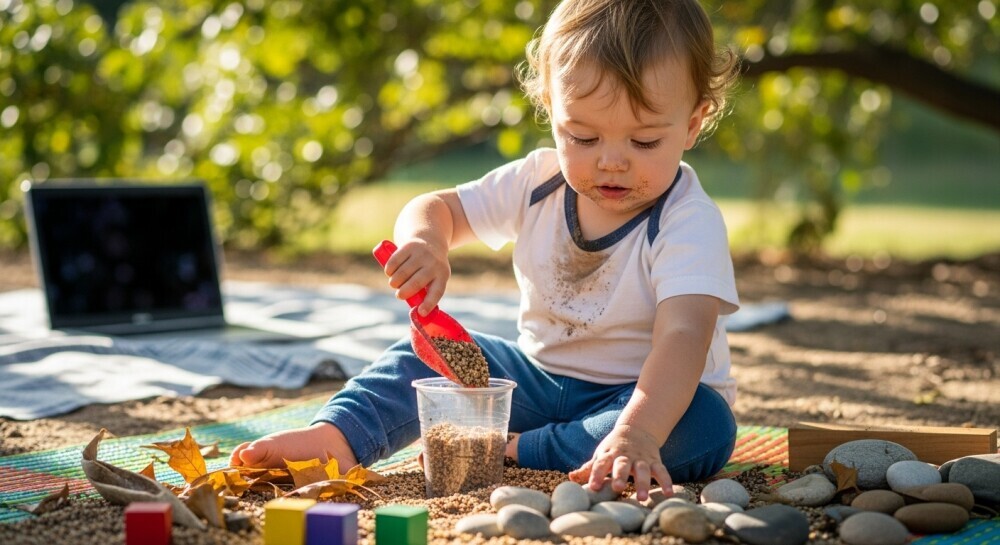
At the same time, you get a block of uninterrupted focus, which might be the difference between finishing one paragraph or knocking out an entire draft.
It also builds confidence and independence. Toddlers love making choices and experimenting in a safe space. That little bit of freedom, whether it’s mixing “soup” with cups or creating their own felt-board story, gives them a sense of control. Meanwhile, you get breathing room to focus on your own work.
The best part? It does not have to be expensive or complicated. Most sensory activities can be set up with simple household items. A bowl of oats, a handful of pasta, or a roll of tape can turn into twenty minutes of play that feels brand new to a toddler. It is practical, affordable, and helps both of you thrive.
¹ “The Benefits of Sensory Play For Your Child,” Cleveland Clinic
Setting Up a Sensory Play Zone That Works for You and Your Toddler
Carving out a space for sensory play doesn’t have to take over your whole house. What matters most is that it’s safe, easy to clean up, and close enough for you to keep an eye on while you work.

Here are a few tricks that make it doable in real life:
- Pick a visible spot. A corner of the living room, a patch of kitchen floor, or even a play mat within sight of your desk works perfectly.
- Plan for the mess. A plastic tablecloth, an old shower curtain, or even a big towel underneath catches spills and makes cleanup a five-minute job instead of a big project.
- Keep a “swap basket” nearby. A bin with extra scoops, cups, or textures makes it easy to refresh the play when attention starts to fade.
- Store it simply. Shoeboxes, Tupperware, or baskets can hold little kits you grab in a pinch when you need a quick blogging window.
For dry activities, you can usually work a few feet away while still supervising. For water or anything messier, sit close by and use it as a lighter work session, like responding to emails or outlining a post. That balance helps keep play safe without needing to hover constantly.
Easy DIY Sensory Play Ideas That Don’t Take Ages to Set Up

When time is short, simple is best. These activities take just a few minutes to pull together with things you probably already have in the kitchen or craft drawer.
Rice Bin Treasure Hunt
Fill a shallow bin with uncooked rice. Toss in spoons, cups, and a few small toys for “hidden treasure.” Toddlers love pouring, scooping, and digging. If you want to make it extra fun, colour the rice with a drop of food colouring.
Oatmeal Dig
A safe and taste-friendly option. Add scoops, bowls, or a few toy animals. Oats are soft and easy to clean up, and the texture keeps little ones busy.
Pasta Play
Use dry pasta shapes with cups and containers for dumping, filling, or sorting. If your toddler is past the mouthing stage, add pipe cleaners so they can thread pasta together.
DIY Play Dough
A quick mix of flour, salt, oil, water, and food colouring makes a batch of dough for rolling, squishing, and cutting. Cookie cutters and a small rolling pin turn it into hours of pretend baking fun.
Pom Pom Drop
Tape cardboard tubes to a wall or box and let your toddler push pompoms or cotton balls through. It’s simple, clean, and builds fine motor skills while you sip your coffee and type a few paragraphs.
Water-Free (and Low-Mess) Sensory Activities for Less Supervision
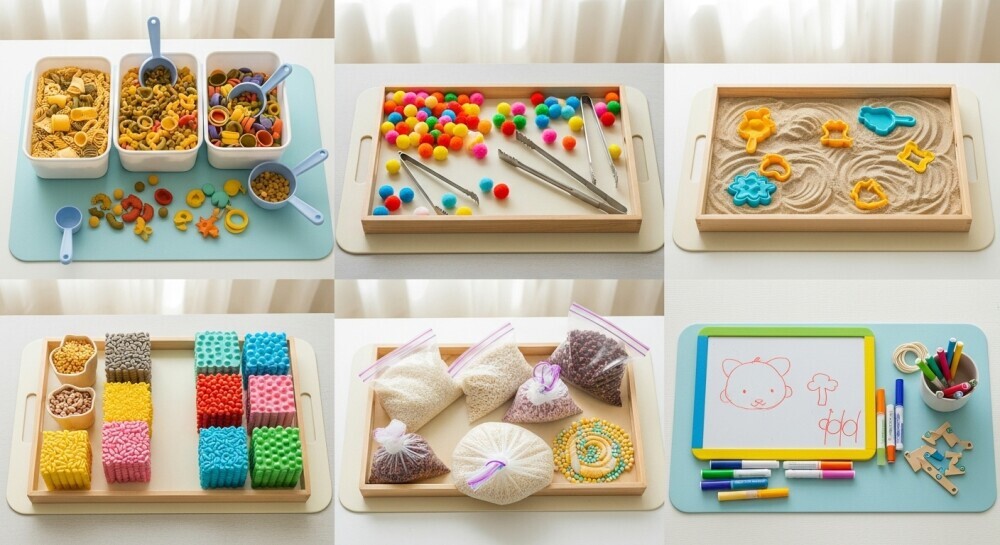
Some days, you need activities that keep your toddler busy without leaving you a giant mess to clean up afterwards. These ideas are my go-tos when I need longer stretches of focus time:
Felt Board Stories
Cut out shapes from colourful felt — animals, houses, trees — and let your toddler stick them to a felt board or even a pillowcase stretched over cardboard. It encourages creativity and storytelling with zero cleanup.
Sticky Wall Collage
Tape up contact paper sticky-side out at toddler height. Give your child pompoms, tissue paper, feathers, or scraps from the recycling bin. They’ll stick, layer, and create little “masterpieces” that change each time.
Textured Sensory Bags
Fill a freezer bag with hair gel, beads, or small toys. Tape the edges shut for safety. Toddlers can squish and move the items around without making a mess. It’s a big hit for curious little hands.
Nature Basket
Grab pinecones, leaves, rocks, and shells from the backyard or a walk. Toddlers love sorting and exploring different textures. It’s a simple way to bring the outdoors in.
You can also create “mystery bags” with different safe household items. Let your toddler feel and guess what’s inside. It keeps them curious and engaged while you sneak in a writing sprint.
Quick Guide: What to Have on Hand for Last-Minute Sensory Play

One thing that makes sensory play work is being ready ahead of time. A small stash of supplies means you don’t have to scramble when inspiration for blogging strikes and your toddler needs something to do.
Here’s a checklist I like to keep stocked:
- Plastic bins or Tupperware containers
- Measuring cups, spoons, and small bowls
- Dry foods like rice, oats, beans, or pasta
- Cotton balls, pompoms, and pipe cleaners
- Food colouring and zip-top bags
- Felt scraps, fabric cuttings, or old socks
- Homemade or store-bought play-dough
- Cardboard, tape, and contact paper
Having these basics in one place makes it easy to rotate activities and keep them feeling fresh. A dedicated shelf or basket means everything is easy to grab when you need it most.
Tips for Keeping Sensory Play Fresh and Interesting
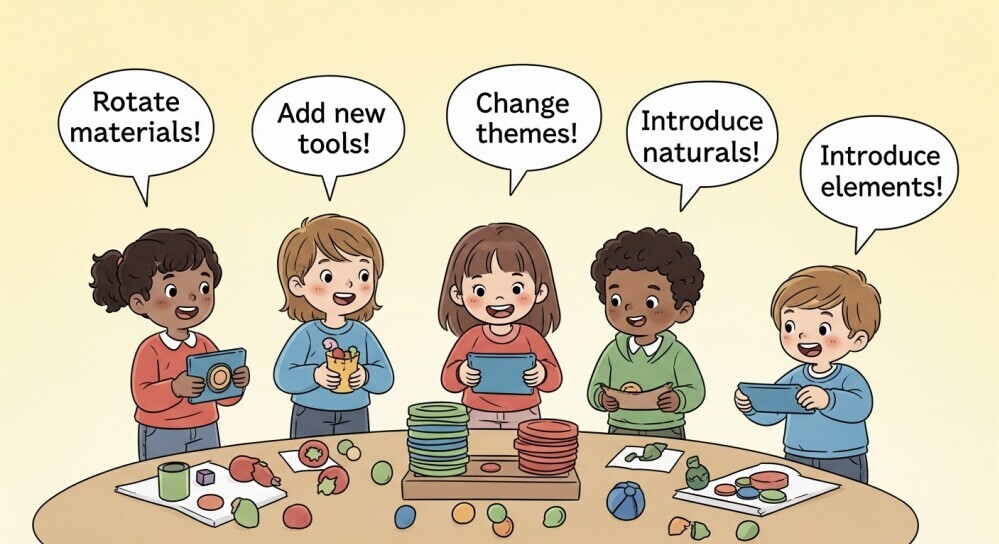
Toddlers love novelty. Even a favourite activity will get old if it looks the same every time. Luckily, it doesn’t take much to breathe new life into sensory play.
Here are a few easy ways I keep things fun:
- Add a theme. Drop in farm animals when you’re writing about farm trips or pumpkins in the fall.
- Switch up the tools. A muffin tin for sorting or a soft paintbrush for brushing dry rice changes how play feels without changing the materials.
- Introduce new colours or scents. A splash of food colouring, a drop of vanilla, or a pinch of lavender makes an old bin feel brand new.
- Rotate textures weekly. One week might be crunchy pasta, another could be soft pompoms. That variety keeps your child engaged (and you from getting bored, too).
- Play with surprises. Toss a few “mystery” items into the bin and ask, “What’s different today?” Toddlers love spotting the new twist.
Even small changes go a long way. Think of it like updating your own workspace — a little refresh can make everything feel more inspiring.
Addressing Common Worries About Sensory Play and Work Boundaries
If you’ve ever hesitated to set up sensory play, you’re not alone. I’ve worried about messes, choking hazards, and whether my child would lose interest in five minutes, too.
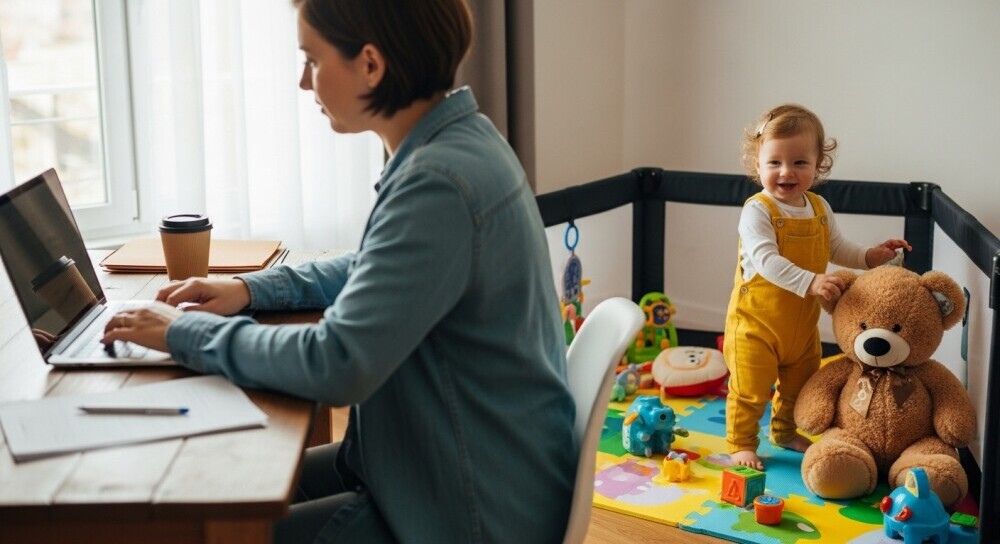
Here’s what has helped me ease those concerns:
- Safety first. Skip small pieces if your toddler still mouths everything. Cooked pasta, thick carrot coins, or whipped potato “cloud dough” are safer, taste-friendly options.
- Keep it simple. Use shallow containers and limit the number of items at once. Fewer pieces mean quicker cleanup and less overwhelm.
- Plan for the mess. Keep a towel, wet wipes, and a dustpan nearby. A quick sweep makes the idea of setting up sensory bins a lot less intimidating.
- Set boundaries together. I like to use a visual timer or say, “When this timer beeps, we’ll clean up together.” It helps my toddler understand when playtime ends and makes transitions smoother.
Work sessions with kids at home will always be a little unpredictable. But with safe materials, quick-clean strategies, and clear boundaries, sensory play can become one of the easiest ways to carve out work time while still keeping your child happy.
Frequently Asked Questions
How do I keep my toddler from getting bored with sensory play?
Rotate the materials often. Swap in new textures, colors, or even kitchen tools they haven’t used before. I’ve noticed that even adding one surprise item, like a new scoop or a different color, usually sparks fresh interest.
How long will sensory play keep my toddler busy?
Most toddlers stick with an activity for 15 to 30 minutes. Sometimes you’ll get lucky and they’ll play longer, especially if it feels new or involves a surprise element. The key is keeping expectations realistic. Even 20 minutes can be a big win for a focused work session.
What if my toddler makes a huge mess during play?
A little mess is almost guaranteed, but it doesn’t have to be stressful. I often set up play on a plastic tablecloth or take it outside. Dry materials can be shaken off easily, and keeping a dustpan and wipes nearby makes cleanup quick. The extra time you get for blogging is usually worth it.
Is it okay for toddlers to do sensory play every day?
Yes! Sensory play is safe and supports development when you supervise and switch things up now and then. Daily play with different textures or tools is a wonderful way to keep your child learning and engaged.
Final Thoughts on Sensory Play During Blogging Sessions

DIY sensory play can be a real game-changer for parents who are trying to balance blogging and family life. With just a little preparation and a few simple materials, toddlers get a safe, creative outlet while you grab much-needed focus time.
The beauty of sensory play is in its flexibility. It doesn’t cost much, it encourages your child’s independence, and it gives you those precious windows of quiet to write, plan, or even sip a cup of coffee while answering comments.
Think of it as a win for both of you. Your toddler explores and learns while you get to move your blog forward. It’s not about perfection, but about creating small routines that let parenting and blogging fit together a little more smoothly.
💬 Let’s Chat
Blogging with toddlers in the house is never easy, but it can be full of creative solutions. I’d love to hear from you — what’s your child’s favourite activity that keeps them happily busy while you get a little work done?
Maybe it’s stirring “soup” in a rice bin, building with blocks, or even joining you at the desk with crayons.
Share your ideas in the comments. Your tip could be the one that saves another parent’s work session this week.


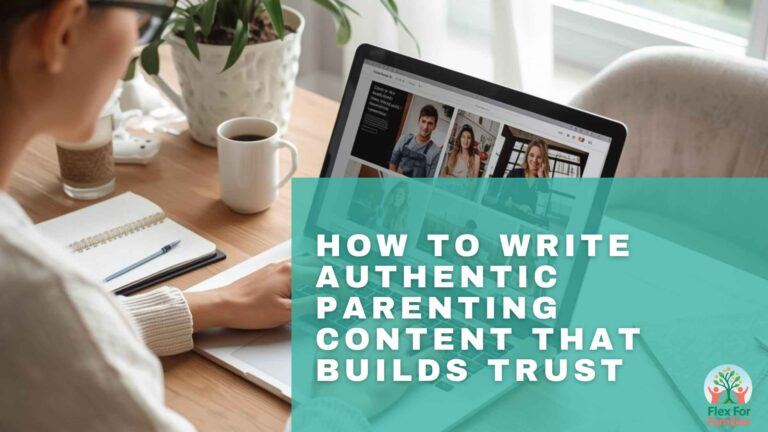


Love these ideas! Sensory play has been a lifesaver in my house too. My toddler can spend ages with a simple bin of oats and a couple of scoops, and it gives me just enough time to finish up a draft or reply to emails. I really like your reminder that it doesn’t need to be complicated or expensive — some of the simplest setups are the most effective. Thanks for putting together such practical tips for parents trying to juggle work and little ones at home!
Thank you so much! I love hearing how other parents are using simple sensory play ideas to create those little pockets of calm. Oats and scoops are such a classic. It’s amazing how something so simple can keep little hands busy and happy.
And yes, you’re absolutely right! It doesn’t have to be fancy or Pinterest-perfect to work. Sometimes the easiest setups end up being the most loved! I’m so glad the tips were helpful, and I love that you’re finding ways to balance creativity, parenting, and work time in such a realistic way. ????
John
Hey, John.
This is such a wholesome and practical piece because honestly, every parent trying to build something from home should read it. I’ve had my share of “toddler interruptions” while writing or coaching online, and sensory play really does feel like a quiet little miracle when it works. The part about using what’s already at home stood out because too many parents think they need Pinterest-perfect setups, but half the magic is in simplicity. I think so.
Just curious. Do you think it’s better to schedule sensory play at the same time each day, or to keep it flexible depending on the child’s mood and your workload? Also, have you ever tried combining sensory play with storytelling like turning playdough time into a mini “story lab” where the child imagines characters or settings while you brainstorm blog ideas?
Either way, this article nails that gentle balance between productivity and presence, something every work-from-home parent keeps chasing. That’s my opinion, anyway. We come from different settins. I am from South Sudan, and parenting here might be very different from any other in other parts of the world.
John
Hey John,
Thanks so much for sharing that — I really appreciate your perspective, especially hearing about parenting from South Sudan. It’s amazing how the core challenges (and joys!) of raising little ones while working from home are so universal, no matter where we are.
I completely agree with you — the beauty of sensory play really is in its simplicity. You don’t need a perfect setup; often, the most engaging activities come from whatever’s lying around.
As for scheduling, I’ve found that flexibility is absolutely key. Every day is different depending on my son’s mood or energy, so I tend to use sensory play more as a reset button than a fixed block. If he’s restless or needs grounding, that’s our cue. It keeps things low-pressure and responsive rather than feeling like another “task.”
I love your idea of turning sensory play into a storytelling space… That’s brilliant! We’ve done something similar with playdough and small world toys, letting him narrate little adventures while I jot down blog ideas nearby. It’s such a nice overlap between creativity and connection.
Do you find certain types of sensory play work better for storytelling with your child? I’d love to hear what’s been most fun or effective for you.
John